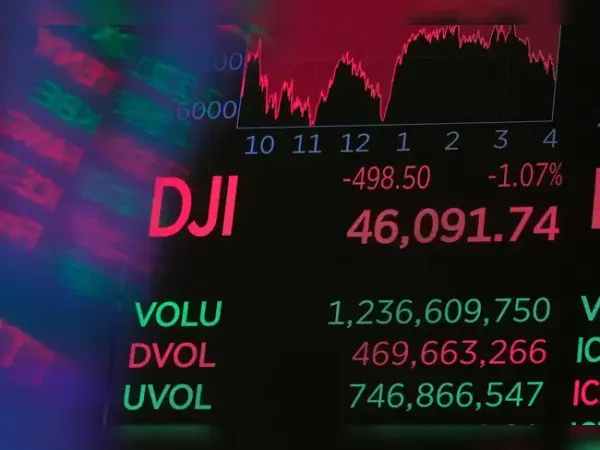US stock market jumped Thursday as Nvidia earnings beat estimates and the tech sector rallied. Nasdaq climbed 2.2%, S&P 500 gained 1.7%, and the Dow Jones rose 1.3%, adding over 500 points. Nvidia shares surged nearly 5% after CEO Jensen Huang said demand for the new Blackwell processors is off the charts. Investors cheered, easing fears of slowing AI hardware sales. The chipmaker’s strong report fueled broader tech optimism, highlighting booming AI adoption and cloud infrastructure investment.
September jobs data added momentum. Payrolls grew by 119,000, far above the 51,000 expected. Unemployment rose slightly to 4.4% from 4.3%, surprising economists and Fed officials. Strong hiring sparked rate-cut hopes, but the mixed signals created caution. Options traders revised December Fed rate-cut odds to 35%, up from 28% earlier in the day. The report gained extra attention after the US government shutdown delayed key economic releases, including October’s jobs update, now rescheduled to December 16.
Fed minutes show a policy divide. The October meeting revealed some officials worry about stubborn inflation, while others want a clear labor market slowdown before cutting rates. This split keeps investors guessing about future Fed moves. Mixed signals on employment, inflation, and economic growth make the December meeting critical for markets. Traders are analyzing every data point, from corporate earnings to AI chip demand, for clues on policy direction.
Retail gains support optimism. Walmart beat third-quarter earnings expectations with higher profits and sales. The retailer also raised its full-year guidance, signaling confidence in consumer spending ahead of the holiday season. Despite strong results, Walmart shares moved only slightly as investors weighed broader economic trends, inflation pressures, and potential holiday retail challenges. Analysts noted Walmart’s performance shows resilient consumer demand, even amid uncertainty, and could indicate strength for other major retailers.
Markets remain watchful but optimistic. Strong corporate performance and economic data are fueling confidence. AI demand, tech growth, and retail resilience are key drivers. Investors are tracking Nvidia’s Blackwell processor sales, upcoming jobs reports, and Fed policy signals. Thursday’s surge shows that when data and earnings align, the market responds sharply, rewarding both tech and consumer-focused sectors.
Nvidia Earnings Propel Wall Street Higher
The Nasdaq Composite led the way, climbing 2.2%, while the S&P 500 gained nearly 1.7%. The Dow Jones Industrial Average rose 1.3%, adding more than 500 points to its total, marking a strong day for the broader market.
The current NVIDIA (NVDA) stock price is approximately $195.62 as of November 20, 2025. The stock traded today between a low of $194.63 and a high of $198.47. It is up about 4.82% today, with a market capitalization around $4.60 trillion.
The company issued a stronger-than-expected fourth-quarter sales forecast and said demand for its Blackwell AI chips is “off the charts.” Nvidia’s results reversed a 7% November slide and reignited the broader AI rally, lifting major chip and infrastructure stocks across the market.
Nvidia’s upbeat guidance boosted major AI-linked stocks, including Advanced Micro Devices, Broadcom, and power-infrastructure suppliers like Eaton. Investors saw the print as a signal that AI demand remains durable heading into 2026.
Tech stocks had struggled throughout November. The S&P 500 was down 3% for the month and the Nasdaq was down nearly 5% through Wednesday. Nvidia itself had dropped 7% in November before Thursday’s rebound. Market strategists said Thursday’s rally reflected renewed confidence that AI earnings can support premium valuations.
September Jobs Report Surprises Investors
On the economic front, the Bureau of Labor Statistics (BLS) released the highly anticipated September jobs report, which surprised economists with much stronger hiring than expected. US payrolls grew by 119,000, well above the 51,000 jobs that analysts had forecast. This sharp increase in employment numbers fueled hopes of a more resilient labor market and boosted sentiment around potential Federal Reserve policy decisions.
However, the report also showed a rise in the unemployment rate, which increased to 4.4% from 4.3% in August. Economists had expected little change, and some Federal Reserve officials had anticipated a modest increase. The combination of strong job creation alongside a slightly higher unemployment rate led to mixed reactions among investors, as the data added complexity to the outlook for future interest rate moves.
Because the recent US government shutdown delayed several key economic releases, analysts and traders put extra emphasis on Thursday’s data. The BLS also canceled its usual October jobs release, rescheduling November’s update to December 16, making this September report even more critical in shaping expectations for the final months of the year.
Federal Reserve Rate Cut
Following the jobs report, options traders quickly revised the probability of a Federal Reserve rate cut in December, with odds rising to nearly 35%, up from 28% earlier in the day and 30% the previous day. This shift reflects growing market expectations that the Fed may take a more accommodative stance if the labor market continues to cool, although uncertainty remains due to conflicting economic signals.
The strong jobs growth provides evidence that the labor market remains resilient, which could make policymakers more cautious about cutting rates too quickly. At the same time, the slight uptick in unemployment gives some leeway for the Fed to consider easing monetary policy to support economic growth. The mixed signals have left investors carefully analyzing every data point, particularly as the Fed’s December meeting approaches.
Adding to the uncertainty, minutes from the Fed’s October meeting revealed a sharp split among policymakers. Some officials expressed concern about persistently high inflation, emphasizing the need to maintain restrictive monetary policy until price pressures ease. Others highlighted the importance of observing a cooling labor market before committing to any rate cuts, creating a divided outlook on future policy.
This divergence among Fed officials underscores why investors remain cautious about predicting the timing of interest rate cuts. While some traders are hopeful for a more dovish approach, the central bank appears determined to weigh multiple economic indicators, including wage growth, consumer spending, and labor market trends, before making decisive moves.
Walmart Raises Forecasts Amid Strong Earnings
Walmart shares rose more than 1% after reporting stronger-than-expected third-quarter results. The retailer posted $179.5 billion in revenue and adjusted EPS of 62 cents, topping analyst expectations. The company also raised its full-year sales outlook.
Palo Alto Networks fell 3% after announcing a $3.35 billion acquisition of cloud-management firm Chronosphere. The deal overshadowed the cybersecurity firm’s better-than-expected quarterly results.
Cloud, retail, cybersecurity, and chip stocks were among the most actively traded groups in premarket and regular trading as investors repositioned around AI demand and holiday-season earnings expectations.
September jobs data added momentum. Payrolls grew by 119,000, far above the 51,000 expected. Unemployment rose slightly to 4.4% from 4.3%, surprising economists and Fed officials. Strong hiring sparked rate-cut hopes, but the mixed signals created caution. Options traders revised December Fed rate-cut odds to 35%, up from 28% earlier in the day. The report gained extra attention after the US government shutdown delayed key economic releases, including October’s jobs update, now rescheduled to December 16.
Fed minutes show a policy divide. The October meeting revealed some officials worry about stubborn inflation, while others want a clear labor market slowdown before cutting rates. This split keeps investors guessing about future Fed moves. Mixed signals on employment, inflation, and economic growth make the December meeting critical for markets. Traders are analyzing every data point, from corporate earnings to AI chip demand, for clues on policy direction.
Retail gains support optimism. Walmart beat third-quarter earnings expectations with higher profits and sales. The retailer also raised its full-year guidance, signaling confidence in consumer spending ahead of the holiday season. Despite strong results, Walmart shares moved only slightly as investors weighed broader economic trends, inflation pressures, and potential holiday retail challenges. Analysts noted Walmart’s performance shows resilient consumer demand, even amid uncertainty, and could indicate strength for other major retailers.
Markets remain watchful but optimistic. Strong corporate performance and economic data are fueling confidence. AI demand, tech growth, and retail resilience are key drivers. Investors are tracking Nvidia’s Blackwell processor sales, upcoming jobs reports, and Fed policy signals. Thursday’s surge shows that when data and earnings align, the market responds sharply, rewarding both tech and consumer-focused sectors.
Nvidia Earnings Propel Wall Street Higher
The Nasdaq Composite led the way, climbing 2.2%, while the S&P 500 gained nearly 1.7%. The Dow Jones Industrial Average rose 1.3%, adding more than 500 points to its total, marking a strong day for the broader market.The current NVIDIA (NVDA) stock price is approximately $195.62 as of November 20, 2025. The stock traded today between a low of $194.63 and a high of $198.47. It is up about 4.82% today, with a market capitalization around $4.60 trillion.
The company issued a stronger-than-expected fourth-quarter sales forecast and said demand for its Blackwell AI chips is “off the charts.” Nvidia’s results reversed a 7% November slide and reignited the broader AI rally, lifting major chip and infrastructure stocks across the market.
Nvidia’s upbeat guidance boosted major AI-linked stocks, including Advanced Micro Devices, Broadcom, and power-infrastructure suppliers like Eaton. Investors saw the print as a signal that AI demand remains durable heading into 2026.
Tech stocks had struggled throughout November. The S&P 500 was down 3% for the month and the Nasdaq was down nearly 5% through Wednesday. Nvidia itself had dropped 7% in November before Thursday’s rebound. Market strategists said Thursday’s rally reflected renewed confidence that AI earnings can support premium valuations.
September Jobs Report Surprises Investors
On the economic front, the Bureau of Labor Statistics (BLS) released the highly anticipated September jobs report, which surprised economists with much stronger hiring than expected. US payrolls grew by 119,000, well above the 51,000 jobs that analysts had forecast. This sharp increase in employment numbers fueled hopes of a more resilient labor market and boosted sentiment around potential Federal Reserve policy decisions.However, the report also showed a rise in the unemployment rate, which increased to 4.4% from 4.3% in August. Economists had expected little change, and some Federal Reserve officials had anticipated a modest increase. The combination of strong job creation alongside a slightly higher unemployment rate led to mixed reactions among investors, as the data added complexity to the outlook for future interest rate moves.
Because the recent US government shutdown delayed several key economic releases, analysts and traders put extra emphasis on Thursday’s data. The BLS also canceled its usual October jobs release, rescheduling November’s update to December 16, making this September report even more critical in shaping expectations for the final months of the year.
Federal Reserve Rate Cut
Following the jobs report, options traders quickly revised the probability of a Federal Reserve rate cut in December, with odds rising to nearly 35%, up from 28% earlier in the day and 30% the previous day. This shift reflects growing market expectations that the Fed may take a more accommodative stance if the labor market continues to cool, although uncertainty remains due to conflicting economic signals.The strong jobs growth provides evidence that the labor market remains resilient, which could make policymakers more cautious about cutting rates too quickly. At the same time, the slight uptick in unemployment gives some leeway for the Fed to consider easing monetary policy to support economic growth. The mixed signals have left investors carefully analyzing every data point, particularly as the Fed’s December meeting approaches.
Adding to the uncertainty, minutes from the Fed’s October meeting revealed a sharp split among policymakers. Some officials expressed concern about persistently high inflation, emphasizing the need to maintain restrictive monetary policy until price pressures ease. Others highlighted the importance of observing a cooling labor market before committing to any rate cuts, creating a divided outlook on future policy.
This divergence among Fed officials underscores why investors remain cautious about predicting the timing of interest rate cuts. While some traders are hopeful for a more dovish approach, the central bank appears determined to weigh multiple economic indicators, including wage growth, consumer spending, and labor market trends, before making decisive moves.
Walmart Raises Forecasts Amid Strong Earnings
Walmart shares rose more than 1% after reporting stronger-than-expected third-quarter results. The retailer posted $179.5 billion in revenue and adjusted EPS of 62 cents, topping analyst expectations. The company also raised its full-year sales outlook.Palo Alto Networks fell 3% after announcing a $3.35 billion acquisition of cloud-management firm Chronosphere. The deal overshadowed the cybersecurity firm’s better-than-expected quarterly results.
Cloud, retail, cybersecurity, and chip stocks were among the most actively traded groups in premarket and regular trading as investors repositioned around AI demand and holiday-season earnings expectations.





